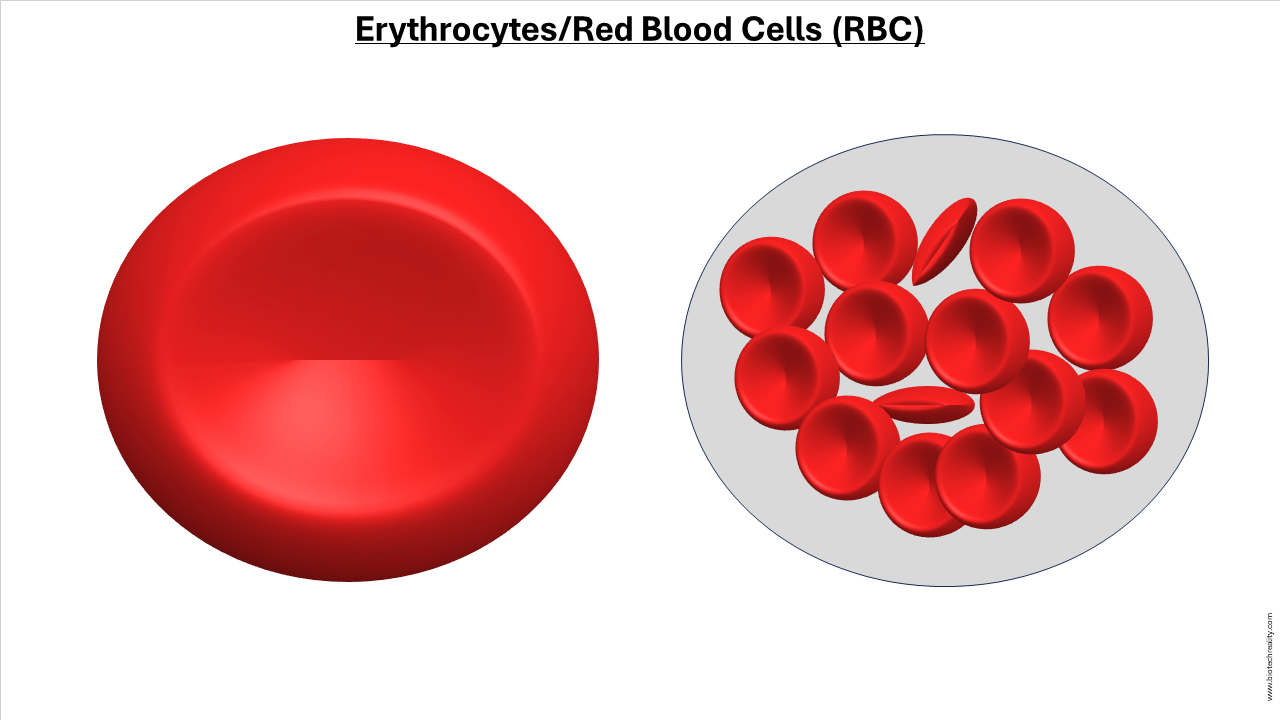Red blood cells, or erythrocytes, are specialized blood cells that are essential for carrying oxygen from the lungs to the rest of the body and carbon dioxide from the body to the lungs for expiration. RBC structure is biconcave disc-shaped and has more room for hemoglobin, the iron-containing protein that binds to oxygen since they lack a nucleus and most other organelles.
Red blood cells are frequently characterized as having a biconcave disk shape. This indicates that the form of the cell is spherical and flattened, with both sides having a concave (hollowed) center. The biconcave form resembles a doughnut with thicker borders and a narrower center. Because of their distinct shape, red blood cells have a larger surface area, which promotes effective gas exchange, particularly when it comes to the transportation of carbon dioxide and oxygen. Red blood cells’ ability to bend and fit through the smallest capillaries in the circulatory system is made possible by their biconcave shape.
Structure of an Erythrocyte
The biconcave structure or disc shape

The biconcave disc shape of red blood cells (RBC structure) is one of its most distinguishing characteristics. Envision a little, pliable disk that is thicker at the borders and thinner in the middle. Because of its increased surface area, this form makes it easier for carbon dioxide and oxygen to exchange gases efficiently. In order to make sure that RBCs can reach even the smallest blood arteries throughout the body, their biconcave shape also permits them to distort when they pass through the tiniest capillaries.
Also Read| Structure of the Human Eye; Anatomy Overview and Functions
A Red Blood Cell’s (RBC) life span is about 120 days. Following this time, the cell ages and loses its elasticity, which increases the likelihood that it will be removed from circulation. Phagocytosis is the process by which old or damaged red blood cells are eliminated from circulation. These old red blood cells are largely phagocytized by macrophages, a kind of white blood cell found mostly in the liver and spleen.
Non-nucleated RBC structure
Red blood cells go through a special process known as enucleation throughout development, during which they shed the majority of their organelles and their nucleus. Their main purpose is to maximize the amount of space for the oxygen-binding protein hemoglobin. RBCs have a limited lifespan of about 120 days since they are unable to multiply or repair themselves due to the lack of a nucleus. Red blood cells are amazing machines of efficiency since they have no nucleus and are just concerned with carrying oxygen.
Also Read| Immunoglobulin (Antibody) – Structure and Types
An intricately organized process known as erythropoiesis starts the journey of a red blood cell in the bone marrow. This mechanism, which is controlled by the hormone erythropoietin, which is mostly generated by the kidneys, makes sure that there is always a supply of new RBCs to replace the aged ones. In response to low oxygen level signals, erythropoietin causes the body to manufacture additional red blood cells in order to maintain adequate oxygen-carrying capability.
Hemoglobin
Hemoglobin, a complex protein made up of four globin molecules and four heme groups in the RBC structure, each of which contains an iron ion, is the basic component of every red blood cell. In the lungs, hemoglobin and oxygen combine to produce oxyhemoglobin, a reversible connection that facilitates effective oxygen delivery. RBCs take up carbon dioxide and release oxygen to tissues and organs as blood circulates throughout the body, generating carbaminohemoglobin. The delicate balance of gases in circulation and the maintenance of cellular respiration depend on the dynamic interaction between hemoglobin and oxygen.
Also Read| Salmonella and Food Poisoning – Salmonellosis
Flexibility
Red blood cells’ ability to bend is essential to their function in circulation. Because of their biconcave form and lack of a hard cell nucleus, they can pass through even the tiniest capillaries without rupturing. This adaptability is necessary to guarantee that all tissues, including the brain’s complex networks and the muscles that require oxygen, will receive it.
Functions
Red blood cells’ main function is to absorb and transfer oxygen from the lungs where it is breathed to all of the body’s tissues and organs. Hemoglobin, a protein found in red blood cells, binds oxygen reversibly to facilitate this process. Essential to the process of exhaling is the transport of carbon dioxide, a waste product of cellular metabolism, from tissues back to the lungs via red blood cells. Bicarbonate ions, which are physically bonded to hemoglobin, are the type of carbon dioxide that is transported in the blood.
Also Read| HIV – Human Immunodeficiency Virus | Details
Author: Achuth B S
Last updated:
Graduated from the University of Kerala with B.Sc. Botany and Biotechnology. M.Sc. Biotechnology from the University of Kerala. Attended certificate course in Artificial Intelligence for Everyone from Deeplearning.AI, Influenza Prevention and Control from World Health Organization. Attended workshops related to Bioinformatics at the University of Kerala. 3 years of experience in website management. Experience in WordPress, Blogger, Google Analytics, and Google Search Console.






